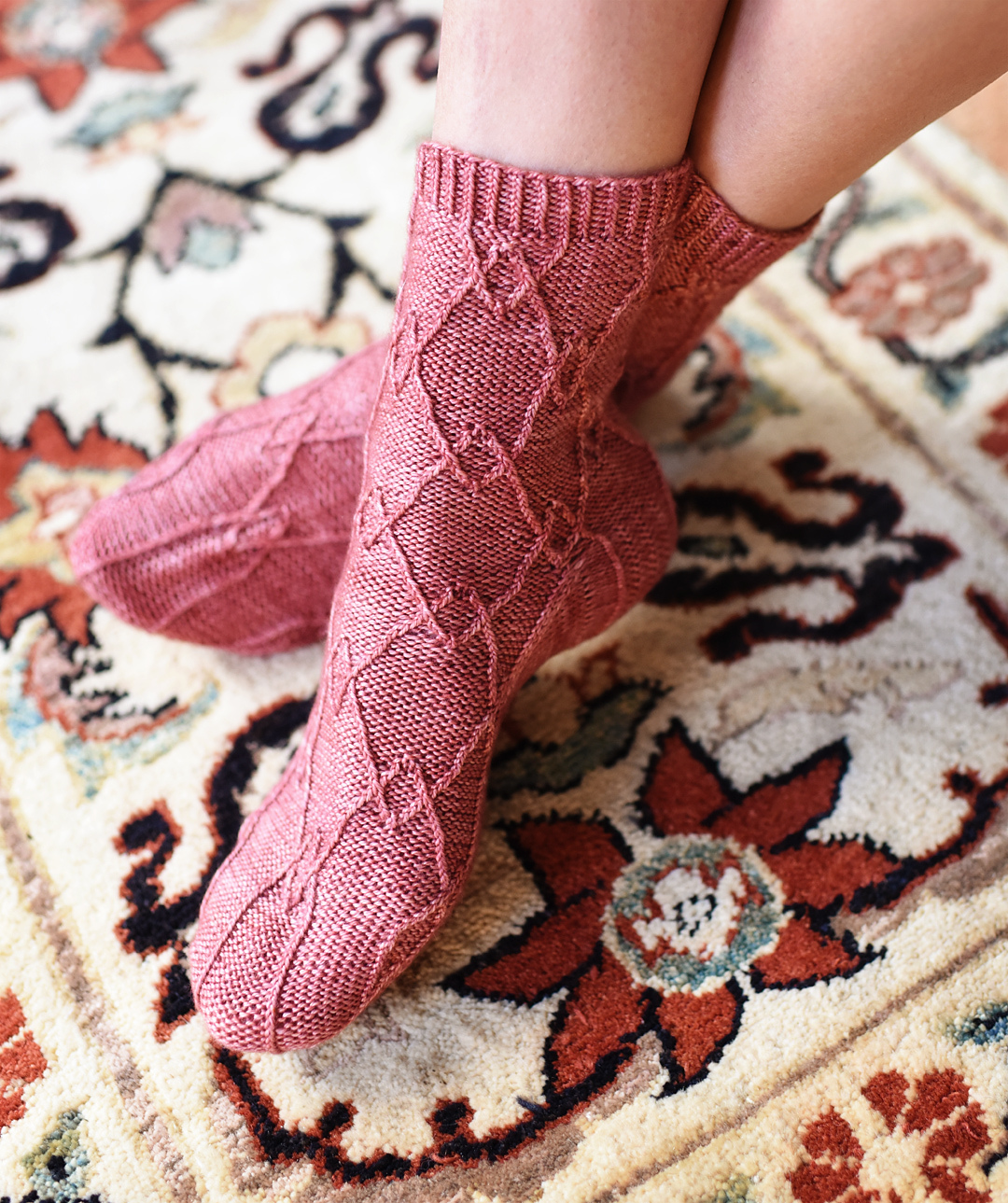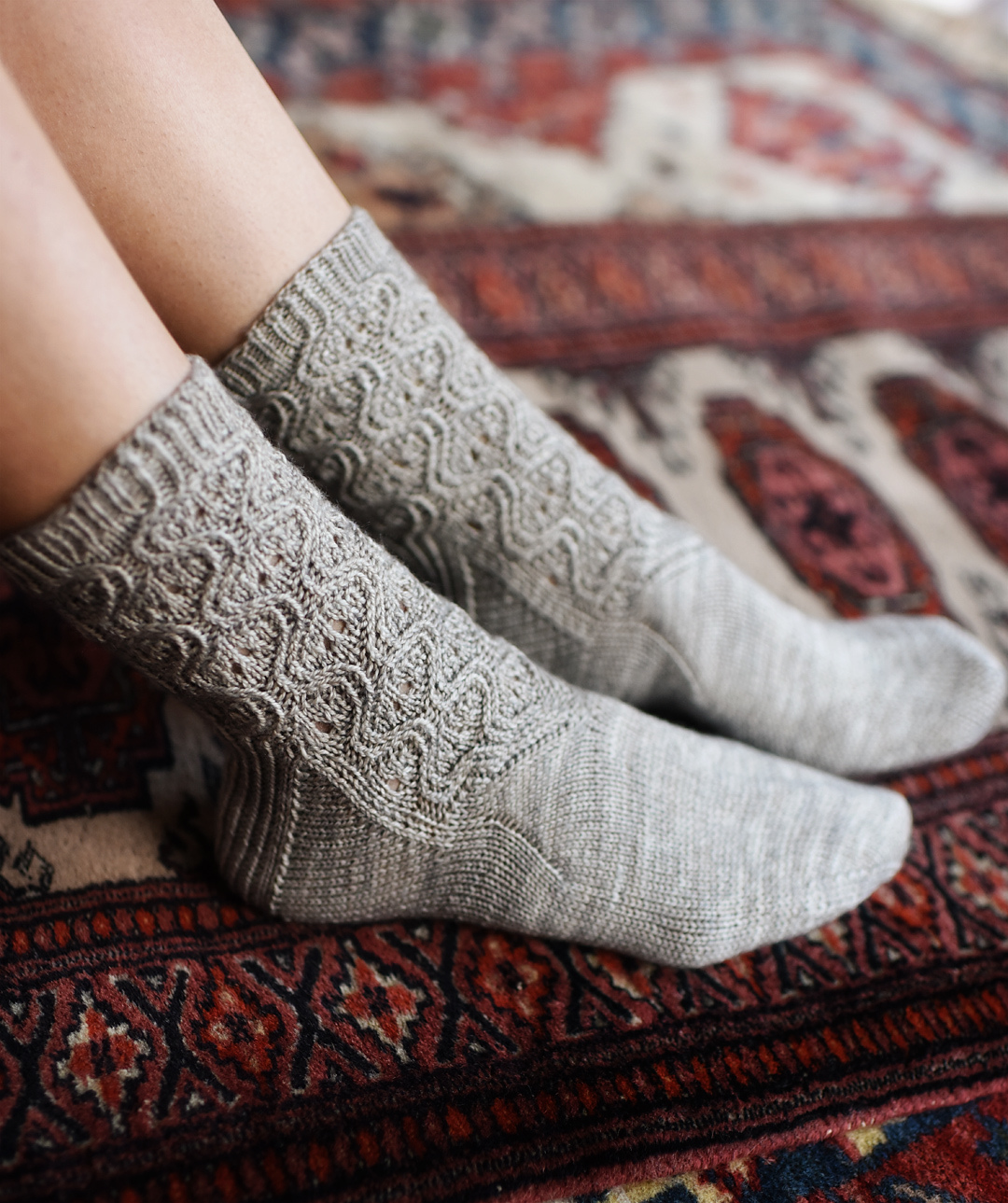Knit Notes: Hunter Hammersen
Hunter sent me a copy of her book a few weeks ago and I immediately wanted to knit a million socks and decorate my entire home in beautiful rugs. As I got started swatching and reading all the history pages I really wanted to talk with Hunter about knitting socks and the book. I learned so much talking with her that I just had to share it with you (with Hunter's permission of course)!
Charlie - Attached are a couple photos of the swatch I did. I plan on retaking them in better light for the post. (I didn't retake them and I forgot to attached them, of course).
Hunter - Hmm, the email gremlins ate them, sorry. I'd love to see them though!
Charlie - Oops, Here they are! I used Anzula Nebula and the recommended needle size. I might need to go up one size, what do you think?
Hunter - So I am particular about socks and gauge/needle sizes. It's part of the reason I'll give people a gauge, and sometimes a range of possible needle sizes, but I absolutely won't ever tell someone 'just use size X needles.' Because it doesn't matter what needle size you're using, it matters what gauge you're getting!
I know a lot of folks default to 8spi (in blocked stockinette, worked in the round if we want to be super particular). But I feel like, in order to have sturdy, long-lasting socks, you actually want to work a bit tighter than that on almost all sock/fingering-weight yarns.
In this book for fingering-weight yarns, I went with a suggested gauge of 8.5 stitches per inch, which totally gives you a more durable fabric than 8. But there are a lot of sock yarns out there where 8.75 or 9 stitches per inch would be even better.
So my official answer is 'are you getting a nice dense fabric in stockinette with your first needles? If so, you're probably right on target (and remember that the lace will be under tension when you have it on, so that will help show it off in a way that can be hard to see in a swatch). Now, if you're actually getting stockinette that's too dense, the sort where it kills your hands to knit it and it feels more like cardboard than fabric, then totally go up a needle size.
That's hard to judge without actually feeling a swatch of stockinette, so I can't say for sure what you should do. But I see far more folks making socks on needles that are too big than on needles that are too small.
Charlie – Well, it looks like I'm getting 7.5-7.75 stitches per inch so based on your advice I think I'll swatch one needle smaller and see how it goes. I definitely want my socks to last as long as possible!
Hunter - Yeah, I'm always amazed by just how tiny a needle I have to use to truly get to that 8+ range on a sock yarn. But I swear it's how you make a sock (especially one in a yarn without nylon) last!
I will confess that I'm a sucker for thick socks though. Most of the ones I knit for myself are out of dk weight (your Cricket makes a great thick sock yarn, it's a good fiber blend for socks and it has a nice density/amount of twist...just be sure to get two skeins!). That's a big part of why I included two sets of gauge/sizing information for all the socks in the book. One is for fingering weight (at that somewhat daunting 8.5spi) and one for sport/dk weight (at a somewhat more relaxed 7spi).
Charlie - I also noticed that my lace stitches are uneven left versus right, do you have any tricks to avoid that?
Hunter - So my first thought is that blocking cures all manner of ills. The very first thing I'd try is blocking your swatch to see if it settles out. If it does, you're great, you're all set. If not, there are more things to try!
Next, I'd make sure that you're swatching the same way you'll be knitting the finished piece. That is, swatch in the round if your actual knitting will be in the round (there's a tutorial on how to do that over here: http://blog.ysolda.com/ysolda-blog/2014/6/5/swift-swatching-in-the-round). This is especially important for stitch patterns that have you doing increases/decreases on every row. If you're working your swatch flat, and you're not as used to doing decreases on the back side of the fabric, that can make things look wonky on the swatch (when they'll be fine on the actual project because you'll always be doing your decreases on the front side there).
Charlie - Yeah, I swatched in the round. Is there anything I can try?
Because you're already swatching in the round, and you're already blocking your swatch, and you still see an unevenness, it's time to get creative. The solution then is usually to change how you're actually making the decreases. There are all sorts of articles out there on how to tweak them, and it's fun to spend some time reading and experimenting to see what works best with your yarn, needles, and style of knitting.
There's a good article here: http://cocoknits.com/tips-and-tutorials/techniques/a-neater-way-to-ssk-2/
and another here: http://techknitting.blogspot.com/2007/09/new-method-for-left-leaning-decreases.html
But trying to change how you actually manipulate the stitches can be a pretty big job (especially if it's something your hands are used to doing on auto pilot!), so I'd totally check your swatches first!
Charlie – I did swatch in the round and I washed my swatch but I didn't pin it out, so it may not be the best point of reference. I'll reblock it with pins this time, (more reminders to do it right the first time). If that doesn't help I am going to check out these resources. TECHknitting is a long favorite of mine and I was introduced to Coco Knits last year by KnitStars.
Hunter - Yeah, try giving it a yank, sometimes stitches just need a little persuasion to line up! And when they're on your feet, they'll be under a bit of tension, so what it looks like blocked is a pretty good idea of what it will look like on your feet.
Charlie - I've been pouring over your new book and there is so much fascinating history along with the patterns. How did your love for oriental rugs turn from hobby to obsessive study?
Hunter - I've actually liked rugs longer than I've liked knitting! I grew up with them (one of my most treasured possessions is a rug that belonged to my great grandfather). And somewhere along the way it became a tradition to get a rug to commemorate big life events (Graduate college? Get a rug. First apartment? Get a rug. Finish grad school? Get a rug. First book? Totally get a rug.)
They're this perfect blend of beautiful and practical (rather like knitted socks!). And they're a marvelous demonstration of how skill and time can turn basic materials into something breathtaking (and something that will last for generations). Add in all the fun history stuff (who makes the rugs? what are those people's lives like? where do rugs go after they're made?), and it's just too much to resist!
Charlie - Agreed! All the pictures in your book show the most beautiful carpets. Where did you start your research?
Hunter - Lots and lots and lots of reading. And it's tricky, because rugs are heavily romanticized, so you have to be careful to find books that are focused on facts rather than trying to tell you a story. But the real history is worth tracking down (and so much more satisfying than the tales).
But, if you want to start learning about carpets, your best bet is to actually go to a good store and lay hands on them. Look for a shop that's been around for a while (avoid anywhere that's constantly having going out of business or moving sales) and spend some time just looking. You'll know pretty quickly if they're something you want in your life!
Charlie - Where is your favorite place to knit?
Hunter - Is it shameful if I admit I'm a TV knitter? I mean it would sound so much more romantic if I described some perfect scene of a roaring fire in an alpine hunting lodge...but mostly it's me tucked up at home catching up on Netflix!
Charlie – Not shameful. At. All. I confess to watching a lot of Netflix, and Hulu, and Amazon Prime while knitting. Lol! So we know you love rugs and knitting, what are your other passions?
Hunter - I am such a homebody! I love cooking and playing board games. But let's all pretend I said something exciting like ice caving or sky diving!
Charlie – Ah, just like the rugs, the reality is so much more interesting than the fantasy. Just for fun name a favorite recipe, favorite game, and favorite show (I have a hundred favorites and know it's hard to choose, so maybe just the ones you're really into right now).
Hunter - Oh let's see...so there are few things in life better than a roast chicken. It makes your house smell amazing, and you've got built in leftovers. I really like the Jamie Oliver Milk Chicken recipe (you can find it over here: http://www.thekitchn.com/jamie-oliver-chicken-in-milk-best-chicken-recipe-all-time-80388 .
For board games, I'm a fan of the 'let's settle in for three hours and really do this' style, so I'm a big fan of Agricola.
And as for tv? Well let's just say I'm very much looking forward to the next season of The Walking Dead!
Charlie - Do you consider yourself a dog or cat person?
Hunter - Kitties all the way! We have two now (and have had several more over the years), and they are totally in charge around here.
Charlie – I love cats! What are their names?
Hunter - This is actually a pretty accurate reflection of my world most days...you've got Levon there in the front being attentive, and Douglas in the background plotting something nefarious. Plus tea...and both rugs (very likely in need of a vacuum) and woolly blankets (in a shamefully untidy state) in the distance!
Charlie - How do you take your coffee or tea?
Hunter - Tea all the way...super strong but with lots of honey and half and half.
Charlie - If you could go anywhere, where would you go and what would you do there?
Hunter - So we're in the middle of moving from Ohio to Maine (as in, I'm surrounded by moving boxes as I type this...remind me not to bring out a book and move at the same time ever again!). So right at this very moment, I desperately want to be in my new house, snuggled up on the deck, staring at the ocean (very possibly with some sort of hot chocolate beverage in hand).
But once we're all settled in there (and I've had a bit to catch my breath), I very much want to plan a trip to Iceland. I've never been, and it's at the very top of my 'I really need to see that' list!
Charlie – I hope your move goes well and nothing, especially your yarnie stuff, goes missing!
Hunter - Hah! Does it make me crazy that all the trunk show samples and all the pieces for next year's book that I have already are going with me in a suitcase in the car? I mean I can buy new pots and pans or lamps if one of those boxes goes missing...but the knitting is irreplaceable!
Charlie - Thank you so much for taking the time to chat with me in the middle of this crazy time in your life. I love your new book and can't wait to dig in deeper.































